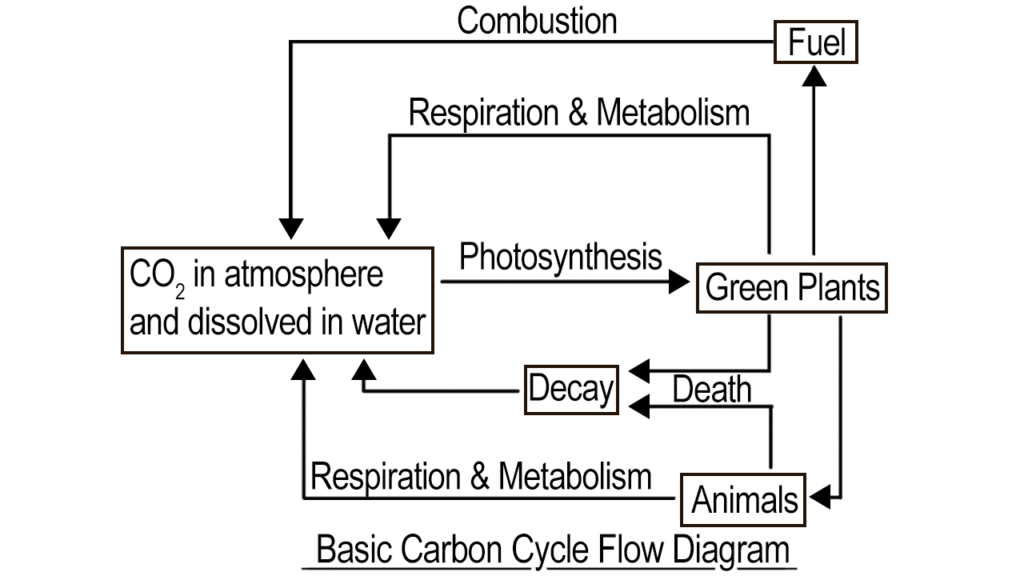DEFINE CARBON CYCLE
The biogeochemical process through which carbon circulates through the Earth’s atmosphere, oceans, and land is known as the carbon cycle. It involves the exchange of molecules containing carbon, including carbon dioxide (CO2), between the atmosphere, the oceans, biosphere, and geosphere.
Using the act of photosynthesis, which turns CO2 into organic compounds, plants along with other photosynthetic organisms takes up carbon via the carbon cycle. After using the organic chemicals for energy and growth, these organisms release oxygen (O2) back into the environment.
Through respiration and decomposition, the carbon in plants’ and animals’ bodies is released into the atmosphere when they die. Additionally, some carbon remains in soil and the oceans, where it may stay for a very long time.
Human actions, such as the use of petroleum and coal and deforestation, have interrupted the natural carbon cycle by releasing huge quantities of CO2 into the atmosphere, causing the global temperature to rise and changes in the climate to occur.
STEPS OF CARBON CYCLE
The carbon cycle involves several steps, including:
- Photosynthesis: During photosynthesis, plants, algae, and certain microorganisms use carbon dioxide from the atmosphere and transform it into organic molecules such as glucose.
- Respiration: When organisms respire, they break down organic substances to release energy, generating carbon dioxide as an outcome.
- Decomposition: When plants and animals die, the organic matter in their bodies gets broken down by decomposers like bacteria and fungus, which emit carbon dioxide along with other gases as they feed on organic material.
- Combustion: When fossil fuels & biofuels burn, carbon dioxide along with additional greenhouse gases are released to the atmosphere.
- Ocean uptake: The ocean collects CO2 from the atmosphere via a process known as diffusion. The dissolved carbon dioxide is utilized for photosynthesis by aquatic organisms and eventually dissolves into marine sediments.
- Carbon sequestration: Carbon may be retained in soil, forests, and other ecosystems for a longer amount of time. Carbon sequestration is a technique that can help minimize the consequences of climate change.

Each of these stages of the carbon cycle are interrelated and occur in real time in the natural environment. Carbon passes through all of these phases in a dynamic equilibrium, keeping a steady concentration of carbon dioxide in the atmosphere. However, human actions such as the use of fossil fuels and deforestation have shifted this equilibrium, resulting in an increase in atmospheric carbon dioxide and contributing to climate change.
IMPORTANCE OF CARBON CYCLE
The carbon cycle is essential to the health of Earth’s ecosystems and the global climate system as a whole. Here are some of the most essential reasons why the carbon cycle is important:
- Temperature regulation: The carbon cycle serves to manage the temperature of the planet by regulating the quantity of carbon dioxide in the earth’s atmosphere. Carbon dioxide is a greenhouse gas that traps heat and warms the Earth. The Earth’s seas, land, and atmosphere all work together to keep the planet’s temperature steady and appropriate for life by taking in and exchanging carbon dioxide.
- Photosynthesis support: Photosynthesis is the process by which plants and other creatures transform carbon dioxide to organic molecules that supply energy to all organisms. The carbon cycle ensures a consistent supply of carbon dioxide for this activity, allowing plants to thrive and contribute to the food chain.
- Carbon storage: The carbon cycle is essential for carbon storage in the Earth’s seas, soil, and plants. Carbon sequestration reduces the quantity of carbon dioxide in the atmosphere, which helps to alleviate the consequences of climate change.
- Fossil fuel reserves: Coal, oil, and gas are derived from ancient plant and animal remnants that have been buried and altered over millions of years. The carbon cycle plays a part for the production and availability of these energy resources, which have aided human growth and contemporary society.
HUMAN IMPACT ON CARBON CYCLE
Human activities have been having significant impacts on the carbon cycle, increasing atmospheric CO2 levels as well as contributing to global climate change. Here are some examples of how people have influenced the carbon cycle:
- Fossil fuel combustion: The combustion of fossil fuels like coal, oil, and gas emits significant volumes of carbon dioxide in the environment. This is the major source of carbon emissions created by humans.
- Deforestation: During photosynthesis, trees as well as other plants capture carbon dioxide from the earth’s atmosphere. Deforestation and changes in land use, such as cutting down forests for agriculture or urban expansion, lower the quantity of plants that can absorb CO2.
- Agriculture and animal production: Agriculture and livestock production contribute significantly to carbon emissions, mostly due to methane generation from cattle and the usage of fertilizers that emit nitrous oxide, a strong greenhouse gas.
- Industrial operations: A variety of industrial activities, such as cement production and steel and aluminum manufacture, emit carbon dioxide and other greenhouse gases into the environment.
- Changes in land use: Human activities such as urbanization and industrialization have resulted in changes in land use that have shifted the carbon cycle’s equilibrium. Conversion of wetlands into agricultural land or urban areas, for example, can release enormous amounts of stored carbon into the atmosphere.
These human-induced alterations to the carbon cycle have raised atmospheric carbon dioxide levels, which are fueling climate change and its effects, including changes to ecosystems and natural habitats as well as increased frequency of extreme weather events and sea level rise. The effects of human activity on the carbon cycle must be lessened in order to protect the ecosystem, and this may be done by reducing our carbon emissions and supporting sustainable land use practices.
Learn more